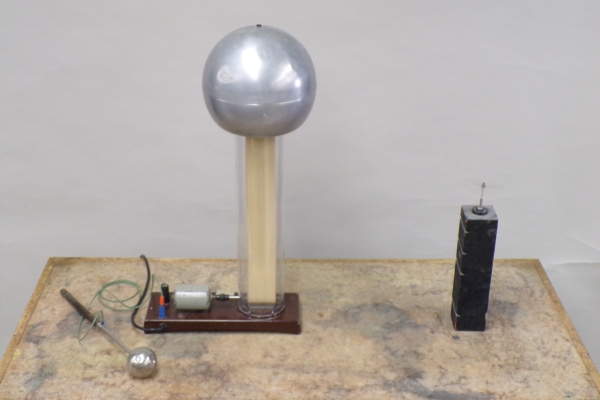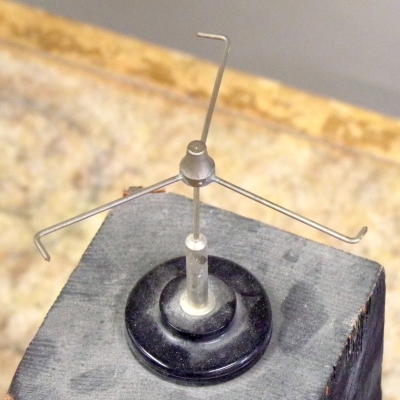 |
 |
When you turn on the Van de Graaff generator, the electrostatic pinwheel sitting atop the black wood block begins to rotate. (It is a blur in the photograph above at left. The photograph at right shows a close-up.) The pinwheel is driven by streams of ions created in the vicinity of, and repelled by, the sharp points at the end of the three arms on the pinwheel. Important! Always use the grounded wand to turn the generator on and off.
When you turn the Van de Graaff generator on, it charges its dome to a high potential, up to around 250,000 volts with respect to ground (see demonstration 56.45 -- Sparks; the dome of this generator charges negative). An object placed near the dome of the running generator will sit at some potential that is intermediate between ground and that of the dome, and will thus acquire sufficient charge to bring it to the potential at that point in the electric field around the dome, in this case, some fairly high negative potential.
Sitting on top of the black wood block is an electrostatic pinwheel (sometimes called an electric whirl), a close view of which is shown in the photograph above at right. The pinwheel has a central hub, which sits on a pivot. Attached to the hub are three arms, each of which has at the end a short section bent at right angles to it, which has a point at its end. When you turn on the Van de Graaff generator, the pinwheel sits in the field produced by the dome of the generator, and it becomes negatively charged. (Normally, an object placed in an electric field becomes polarized. Though the air is not very conductive, there is enough leakage of charge from the dome of the Van de Graaff generator for the pinwheel to charge to whatever the potential is where it sits.) The electric field around an object depends on the charge density on its surface. For a given electric potential, the smaller the object, the greater the surface charge density, and the greater the electric field. At a sharp point, the electric field can be huge. In air, there are always a few electrons and ions, either from cosmic ray bombardment or natural radioactivity. In the large field around a sharp point, both electrons and ions near the point can acquire enough energy within their mean free paths to ionize other air molecules. In addition, if the point is negatively charged, it is possible for electrons to be emitted from its surface. Whichever way it is charged, the field can be high enough to cause ionization of the surrounding air (by polarizing molecules so strongly that they release electrons). This silent type of discharge near sharp points is called corona discharge. Whether the point is positive or negative, the combination of processes described above produces a stream of ions of the same sign as the charge on the point, which is known as the electric wind, or sometimes ion wind or ionic wind. (See, for example, Robinson, Myron. American Journal of Physics 30, 366 (1962).) This phenomenon has recently found use as a substitute for mechanical fans. (See, for example, Ion wind generation and the application to cooling and Electrohydrodynamic (EHD) Cooled Laptop.)
For the charge distributed over the surface of the pinwheel, the density is greatest at the points at the ends of the arms, and the electric field there is large enough to produce corona discharge, with the associated electric wind. In agreement with Newton’s third law of motion, the mutual repulsion between the point at the end of each arm and the stream of (negative) ions flowing away from it, produces a torque on the pinwheel, and it spins.
If the Van de Graaff generator, and thus the pinwheel, charged posistive, the same thing would occur. The processes involved in the corona discharge would produce a stream of positive ions at the tip of each pinwheel arm. The positive ions and the positively charged points of the pinwheel would repel each other, and the pinwheel would spin.
References:
1) Halliday, David and Resnick, Robert. Physics, Part Two, Third Edition (New York: John Wiley and Sons, Inc., 1978). Page 640 has a note regarding corona discharge.
2) G.W. Trichel gives a good description of the mechanism of negative corona discharge across a gap in Physical Review, 54, 1078 (1926).
3) Two papers that discuss field emission from points are Millikan, R. A. and Eyring, Carl F. Physical Review, 27, 51 (1926) and Eyring, C. F., Mackeown, S. S. and Millikan, R. A. Physical Review, 31, 900 (1928).
4) Hyperphysics entry on the Van de Graaff generator and ionization of air.